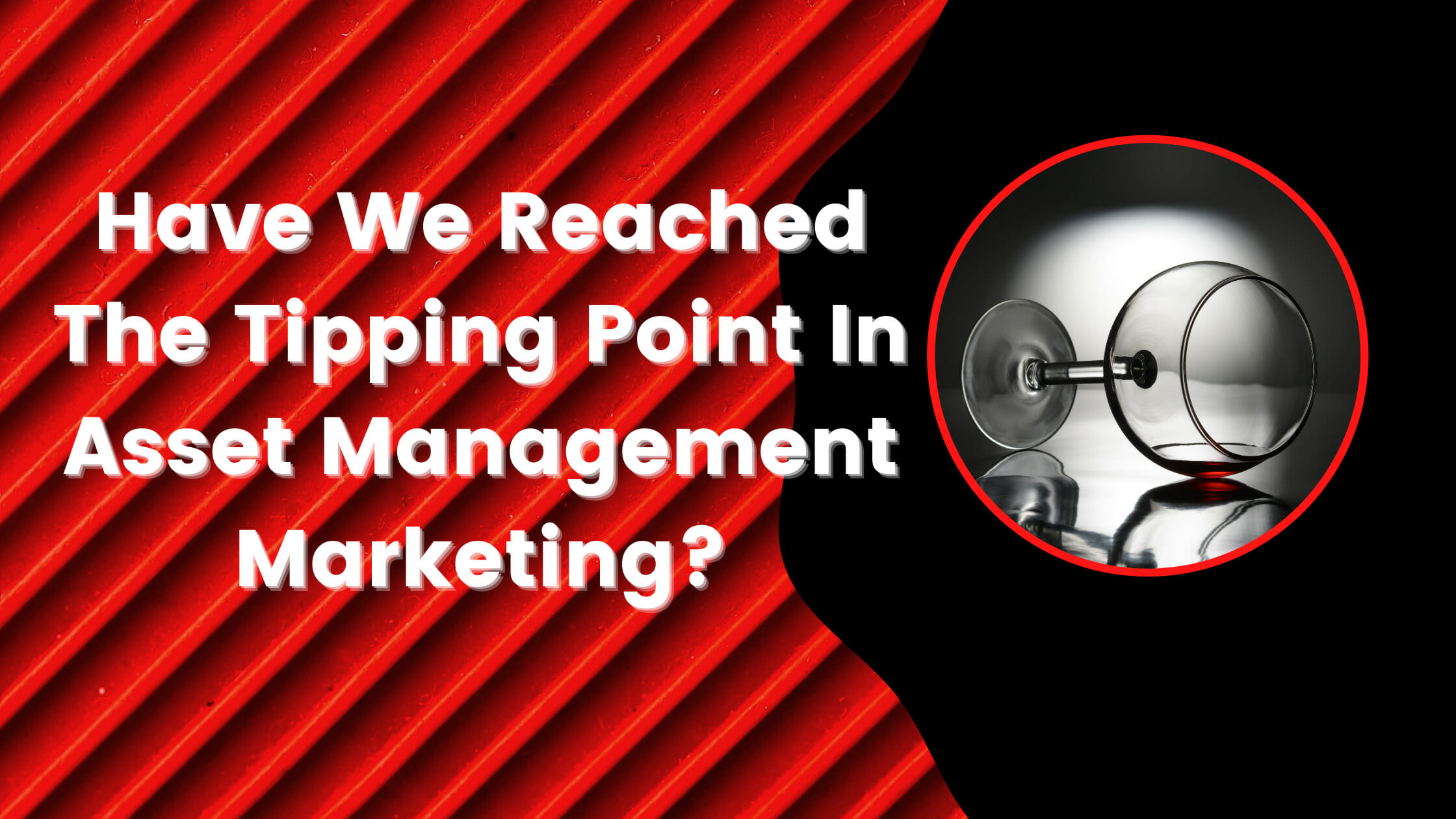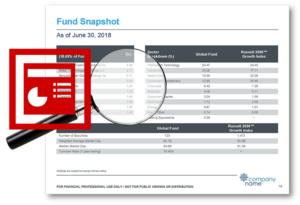The Tipping Point for Asset Management Marketing

Every January, I call up my friend, Andrew Corn, to get his predictions on marketing trends for the year ahead. He always has interesting things to say. He has an impressive background in many areas of financial services and marketing. His career has spanned across consulting, marketing, advertising, Chief Investment Officer – Equities, index designer, multi-factor model creation, and agency head. He is an expert at uncovering and enhancing asset gathering campaigns and designing and implementing marketing funnel optimization for both consumer and B2B audiences.
According to Mr. Corn, there are a couple of major trends going on in the industry right now, and they’re really a continuation from the past couple of years. Specifically, the move from active to passive investing and fee compression are persistent issues that have now become acute. According to Corn, we’re at the tipping point for asset management marketing.
“This move from active to passive is happening so much faster than anyone was able to predict. The upside is that many companies have been able to launch products and gather quite a bit of assets into them. The downside is fee compression. In fact, there is a race to zero, where Fidelity has actually introduced products with no management fee. Now, there are other ways for them to make money, but this fee compression is certainly creating enormous pressure on firms to differentiate,” he said.
If this is the tipping point for asset management marketing, what should teams be doing to help their firms survive in this very competitive market? Read on to hear insights and advice from Andrew Corn in our latest interview.
What is the #1 thing firms can do to prevent outflows and combat fee compression?
There are really two things asset managers can do. One is getting marketing communications out better and more succinctly than ever before. The second is cutting costs. If you’re not cutting them short-term, you need to be cutting them long-term.
One of the trends that comes to mind that we recommend to our clients is marketing automation. If I have 25 or 75 funds, and I’m putting out fact sheets, updating pitch books, and doing all sorts of calendar-driven marketing materials, then I want them to be better, more timely and, of course, I want to produce them for less money over time than my competition. The answer to all three of those criteria is an automation system. Then, once I’ve automated the documents, how do I get them into the right people’s hands?
In advertising, we say, “The right message at the right time and the right place.” This is important when we talk about ads and media, but it’s equally important for what we call the last mile. It goes directly into the sales process. If I’m a salesperson pitching a large registered investment advisor (RIA) who has 500 clients and billions of dollars under management and they’re considering my product, I want the most up-to-date information in my completely custom-designed presentation. And I need my fact sheets current. I need everything up-to-date. If I have the ability to run a custom document and didn’t just have to go with the quarterlies, that will deliver the right information and might be very impressive, as well.
Anything that can be automated is going to save the firm money long-term. It’s going to make them more timely, which will make them more relevant. And they don’t have to worry about being the last one to publish information.
Automating marketing production and sales enablement is certainly important. What advice do you have for asset managers who need to invest in these technologies, but are being told to cut costs?
You can save money and enhance the process simultaneously. People instinctively understand this digital transformation. It makes things more accurate, faster, and more customer-centric. It works in person or on the web, and it saves money at the same time. There are fewer humans to make mistakes, or to eat up time, or to be sick that day, or anything else that happens with humans. Humans are needed, but repetitive tasks should be automated.
It all comes down to prioritization and resource allocation. For example, let’s say a firm has 55 fact sheets and hundreds of presentations that need updating with similar information for every sales channel. There are A shares, B shares, and C shares, all used for different things with different fee structures for different pitches…then it’s really 165 fact sheets. The resource allocation for this effort is something that firms gear-up for each quarter, and then there’s a race to get this stuff out as soon as the data is ready. The problem is the data isn’t ready by 4:00 p.m. on the last day of the quarter closed. Instead, marketers are waiting on final calculations, verification by performance measurement, and the list goes on. This adds time to the process. Data velocity should be the number one priority.
Then, there’s the issue of competing for resources in the graphics area to get all this done. Why should marketers compete for resources when a machine can perform the same task in minutes? What is there to gain anyone have to proofread things two and three times when a machine’s not going to get it wrong to begin with, and if it does, it’s going to be two standard deviations away from anything else anyway, so it will be noticed quickly. Why wouldn’t we just go with the machine process and automate it?
Getting to market sooner and having stronger concepts and better work is how firms need to differentiate. If a firm spends 10 thousand human hours on marketing, they may save money on 2,500 of them. The first two or three years is payback, depending on my ROI calculation for the automation. After that, the savings are just going to the bottom line. But saving that 2,500 hours is going to make a better firm with better marketing and better graphics because people are going to have time to think things through because I’ve just saved 5,000 hours and I’m keeping 2,500 of them.
It always comes down to the data, really. Is there such a thing as “golden source data”? Does it exist?
If you’re waiting for a golden potential data source, it doesn’t exist. It never will. That’s an excuse not to do this kind of automation project for years, which is not going to look very good when McKinsey (or Bain, or FTI) comes in to look for efficiencies in your company. Firms should already be on top of this and implementing it. If not, one of the consultancies will be coming in and saying, “Why the heck haven’t you done this already?”
Right now, the largest asset managers are growing their assets rapidly and laying people off at the same time. There are more assets under management but fewer employees because, on the investment side, things are moving from active to passive, which is more automated, which requires fewer people and generates smaller fees in which to pay for people. Many of these firms have already beaten up on the back office a bunch, and there’s probably more to do there. But, you can’t touch marketing and sales, because they’re the revenue generators.
So are you saying marketers shouldn’t be afraid of losing their jobs due to automation?
If you’re doing a very repetitive job and that’s all you do, you might lose your job, but it’s more likely your job will just change because there’s always more to do in marketing.
Let’s look a little bit north of Chicago and go to an auto assembly plant, where you have robots and people working side-by-side. Now, think about how their job has changed. It requires fewer people and those robots were expensive to buy, but once they’re there, their maintenance cost is very low. Automation in the software world is similar. It’s going to cost a bunch of money to get it going, but then you’re just maintaining it. It does require fewer people. An organization then has to say, is it going to reallocate those resources elsewhere, or does it need less?
We need to address head-on the reality of some potential job loss when fees are lower and the competition is getting faster. What we can concern ourselves with is, who’s going to operate the system, and do they have the skillset for it? If they are graphic designers, then why are they updating fact sheets anyway? They can be doing work that only a human can do, which there’s tons of. Automation doesn’t think, it executes.
The whole thing comes back to resource allocation. If my graphics department has 10 thousand people-hours a year, how much of that do I want to dedicate to updating pitch books and fact sheets? If it’s half my budget, then maybe I want to take a quarter of those hours out and save the money on them, which may mean some people losing jobs, and take 2,500 of those hours and do a better job on everything else.
I can’t predict what companies are going to do. They may layoff people and then have to hire back. We saw that in 2008. But now, as people are experiencing fee compression, which is affecting their revenue, which affects their bottom line, that is going to cause layoffs, anything that can be automated is absolutely a plus because the layoffs are going to happen with or without automation. The question is, will your firm get the work you need done in a timely manner and executed with world-class precision? Automation can absolutely enable that.
What can marketers do to insulate their jobs? What’s the career strategy?
Well, marketers need to learn skills that only a human can do. In every organization, that’s going to be a little different, but certainly, anything dealing with strategic planning. You need to up your skillset. This might require some professional development. You need to understand where your firm is going, and then make sure you have the skills to provide value toward the goal. Every company’s going to be different. Focusing in on things that require thought processes that can’t be automated is really where you want to be. Machine learning is not going to replace writers, for instance for portfolio reviews and other real thinking-based writing.
You said technology isn’t meant to think, it’s meant to execute. That said, what is the role of AI and how will it affect asset management marketing?
I think AI is a lot of promise and very little delivery in marketing today. If you read the MIT newsletters on AI, and now the Wall Street Journal has a customized homepage for AI, and I read both almost daily, it’s just not there yet. It’s got a lot of downsides, AI. The biggest part of AI that’s failing is it’s written completely by a specific demographic of males. Its results over time show that. It’s got a lot of bias in it, which makes it not as effective as it will eventually be. And it’s still very primitive. We’re probably 10 years away from having true AI.
If AI is written by introverted stereotypical male programmers, it’s going to be written from that perspective. That’s why we need more women and women, and people of color as project managers, to counterbalance that.
So, how do firms leverage all the benefits of automation, but still tap into the human side? Surely, this is where true differentiation lies.
That’s what sales is all about. I’m looking at two large-cap growth funds. They shouldn’t be all that different by definition, so what are you going to do to make yours stand out? Why am I going to pick one over the other? If it’s a pure quantitative decision, then we don’t need marketing at all. And it isn’t, because everyone is human.
Frankly, with all the marketing automation, the need for great messaging is only growing, because there are more materials out there. So many of them are inferior because they’re not being done by true marketing professionals. Firms can go out with a new marketing and sales message at scale because it’s automated. Then, there should be enormous monitoring to make sure the sales force is focused on what it should be.
Let’s talk about that. How should firms be monitoring the message that the sales force is using?
When salespeople want too much flexibility because it’s all a custom world, they’re not used to the compliance that drives an asset management firm that’s usually both an RIA and a broker-dealer. We live in the reality of compliance. If I can have something that’s up to date, compliant, on-message for the entire corporation and looks right because it’s on-brand, that’s 90% of my battle right there.
With the right automation, a salesperson should be able to go out with component blocks that are accurate, timely, and compliant and put those blocks together however they want, with pages they’re allowed to customize for that specific customer. Or, pull data in a customized way that’s sitting in the database, and they can actually get it out and into a presentation that is accurate, timely, and compliant. That would be the perfect world.
Last question: Why now?
Well, technology like this has been around in one form or another for 20 years. It has never been more efficient or more streamlined than it is now, which makes sense. But there’s also only been a couple of times where we’ve been at a tipping point, where doing this may make the difference between lots of layoffs and only a few layoffs. This may mean the difference between a firm thriving and a firm surviving. You know you need to reduce your time to market. You know you need to automate repetitive tasks. If you haven’t implemented tech and processes to improve efficiency and cost containment, it’s now or perhaps never.
Here are some related resources that might interest you:






 Compare the Top 3 Finserv Content Automation Vendors [White paper]
Compare the Top 3 Finserv Content Automation Vendors [White paper] Create Pitchbooks the Drive Sales [White paper]
Create Pitchbooks the Drive Sales [White paper] Build vs. Buy: Should Your Financial Services Firm Outsource or Insource Marketing Technology? [White paper]
Build vs. Buy: Should Your Financial Services Firm Outsource or Insource Marketing Technology? [White paper]  10 Tips for Rebranding your Fund Marketing Documents [White paper]
10 Tips for Rebranding your Fund Marketing Documents [White paper]

